Littered with more than 3,000 years of history, Italy is a sightseer's paradise. Spend some time in Rome taking in famous sites like the Colosseum, the Trevi Fountain, the Spanish Steps, and the Pantheon. With artworks on display from the likes of Da Vinci, Caravaggio and Botticelli, it's a visual buffet for all visitors.Head north to explore the canals of Venice by gondola, or indulge in the wonderful shopping in the fashion capital of Milan. A little further south is the magical city of Florence, teeming with culture and Italian flair. Continue south past Rome to Naples and explore the ruins of Pompeii and Herculaneum, destroyed by Mount Vesuvius, which can be seen standing sentinel over the city. Italy takes a lifetime to explore properly because there is so much on offer for visitors. From the gondola-lined canals of Venice to the white sandy beaches of San Remo, to the Alps, Dolomites and Apennines, Italy has everything from beach holidays to luxury mountain ski resorts and a whole lot more in between.The most popular time of year to visit Italy is during the summer months when most of the country can be enjoyed like a fine Italian wine - slowly. A trip to the rolling hills of Tuscany is in order to sample some fine wine and olive oil, as well as plenty of old style Italian cuisine, while taking in the scenery of cypress trees, lush vines and olive groves. The more adventurous travellers can head to the Italian Alps and visit the resorts of Courmayer and Brevil Cervinia for some world-class skiing.
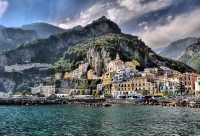
The town of Amalfi sits elegantly against a backdrop of steep cliffs and thickets of lemon trees. Terraced buildings climb down to the shoreline, their pastel hues enhancing the fairytale allure of this Italian seaside retreat.A centre of rich historical significance, Amalfi was once one of the great maritime republics which thrived off trade and rivalries with Pisa, Genoa, and Venice. The Piazza del Duomo (the Cathedral Square) is the main hub, and is dotted with cafes, gorgeous boutiques, and romantic restaurants. A promenade allows visitors to gaze over the picturesque marina and beyond to the memorable emerald waters.The main beach is the Marina Grande, a sheltered beach at the foot of the town. It's a shingle beach, as is common along the Amalfi Coast. Those seeking sand must head out to the villages of Minori and Maiori.While for many visitors a trip to Amalfi is all about soaking up the sun with a drink in hand, there are also some attractions for those looking for a more cultural experience. The 9th-century Amalfi Cathedral is a breathtaking example of Arab-Norman Romanesque architecture. The town is also home to a couple of museums, including the fascinating Museo della Carta and the Arsenal of the Maritime Republic.
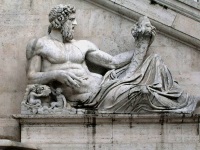
Capitoline Hill was the original capital of Ancient Rome and continues to serve as the seat of the city's government. It is the smallest, but also the most famous, of the Seven Hills of Rome, and once housed the Senate. The main feature of the area is Michelangelo's Piazza del Campidoglio, a testimony to the superiority of Renaissance town planning. The piazza is bordered by three palaces: the Palazzo dei Conservatori and the twin structures of the Palazzo dei Senatori and Palazzo Nuovo, which house the Musei Capitolini, containing the largest collection of Classical statues in the world. Among the notable statues found here are the Dying Gaul and the Satyr, the Capitoline Wolf with Romulus and Remus, and the Spinario. Paths cut along the side of the hill from the Campidoglio allow visitors to enjoy breathtaking panoramic views of the ancient sites of the Forum and Colosseum. Exploring this historic area is a must for anybody interested in ancient Rome and the sense of age and power is thrilling. Although the buildings are not all old the hill gives an amazing sense of what it must have been like during the peak of the Roman Empire. The steps to the top can be a bit daunting but the climb is well worth the effort, and there is access for disabled visitors.
Address : Piazza del Campidoglio, Rome
Website : www.museicapitolini.org
Telephone : +39 06 0608
Opening times : Museums are open Tuesday to Sunday, from 9am to 8pm. Closed 1 January, 1 May, and 25 December.
Admission : €15 (adults) for access to all the museums, with concessions available.
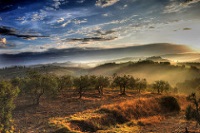
A circular route from Siena through the Chianti hills provides visitors to Tuscany with a wonderfully scenic and sensory travel experience. The route covers the villages of the Chianti Classico wine region, garnished with ancient castles and rambling farmhouses. The vineyards and wooded hills of the Chianti are best explored along its winding back roads or from within its sleepy hamlets. By car, visitors should keep a lookout for signs marked 'vendita diretta' ('direct sales'). The first stop is at Castello di Brolio, a magnificent vineyard owned by the Ricasoli family since 1167. The SS484 will take you south of Brolio and north past the hamlets of San Gusme, Campi and Linari before rejoining the road for a diversion to the Meleto castle. Another worthwhile stop is at Badia a Coltibuono, for its restaurant and Romanesque church. The winding road west to Radda, in Chianti, is especially picturesque. A further nine miles (15km) from here is the hamlet of Volapia, a delightful place which makes you feel as though you've travelled back in time; as does a visit to sleepy Castellina. Within the ramparts of this walled village is the Bottega del Vino Galla Nero, at Via della Rocca 13, showcasing the region's delectable wines and olive oils. There are many potential detours and attractions in the region and although it is a good idea to pick a few desired stops in advance it is a joy to just get lost in the area.
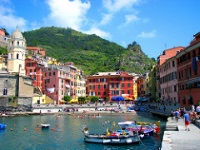
Strung along just over 11 miles (18km) of rugged cliffs between Levanto and La Spezia, the UNESCO-listed Cinque Terre is one of Italy's greatest treasures. Cinque Terre means 'Five Lands'. These are the five related fishing villages that nestle precariously on the cliffs, overlooking the azure ocean of the Italian Riviera, off the country's northwestern coast. Cinque Terre is a picture-perfect dream of sparkling clear waters and dramatic vistas, contained within the tranquil embrace of the villages that are connected to one another by a scenic pathway that curves through the hillside among olive groves and vineyards.Monterosso is the largest of the towns and is recognisable through the huge statues carved into the rocks facing its shores. The village of Riomaggiore is quickly identified through the myriad fishing boats festooning its shores and is linked by the 'lovers lane' to the charming town of Manarola. Corniglia perches precariously on the mountainside and is accessed through a steep climb, and Vernazza's promenade and piazza have beautiful sea vistas. A stroll along these dramatic cliffs is one of the most splendid walks in the country, and photographers will be captivated by the camera fodder. Cars and motorbikes are not allowed in the villages and Cinque Terre is part of a national park.
Website : www.cinqueterre.com
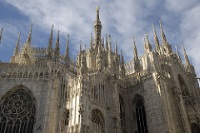
The looming Duomo, one of the world's largest Gothic cathedrals, presides over the Milanese Piazza that bears its name. Its construction began in 1386 and continued sporadically until Napoleon ordered its completion in 1809. Its lengthy creation bestowed on it 3,400 statues, 135 spires and 96 gargoyles. It is best visited in full sunshine when the interior is illuminated by the colourful mosaic of its stained glass windows. The church is a five-aisled cruciform seating 40,000 worshippers. The 16th-century marble tomb of Giacomo de Medici lies in the southern transept, and lying buried at its heart is St Charles Borromeo, the cathedral's most important benefactor. Every year in May and September a nail from the cross of Christ is displayed to worshippers, retrieved from its resting-place by the bishop who is hoisted to the nivola to reach it. Across the piazza, in the Palazzo Reale, is the Museo del Duomo that displays the treasures from the cathedral. It also houses the Museo d'Arte Contomporanea, showcasing a collection of Italian Futurist art. The cathedral is the centre of Milan, both literally and figuratively, and the square is a wonderful meeting place and landmark - the city's roads radiate out from the square and it makes a glorious starting point for explorations of Milan.There are admission charges for certain parts of the cathedral.
Address : Piazza del Duomo 18
Website : www.duomomilano.it/en/
Telephone : +39 02 7202 2656
Opening times : Open daily from 8am to 7pm.
Admission : There are a variety of ticket options available. Check the website for further details.
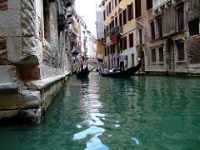
Surely one of Italy's most iconic images is that of gondolas being oared through the narrow canals of Venice by stripe-shirted, serenading gondoliers. These flat-bottomed boats are unique to the canals and waterways of Venice, and taking a ride in one is considered by many to be an obligatory tourist activity while on holiday in Italy. Although you will pay dearly for the experience (roughly €80 - €90 for a 40-minute trip), taking a gondola ride in Venice is sure to leave you with a warm and lasting memory of your vacation in Italy. Tourists are encouraged to make the most of the investment, however: take a trip down the back canals of Venice, and not the Grand Canal which is too crowded and impersonal; pick an ornately-carved gondola, with a comfortable seat and blankets if it's cold; and be sure to ask your gondolier if he is of the singing variety before getting into the boat - although it is compulsory for them to wear black pants, striped shirts, closed shoes and (weather-permitting) their straw hats, they are not actually required to sing.Gondolas are available throughout Venice and can be hailed as one would an ordinary taxi. If you book one through a hotel or tour company, you will probably end up paying a surcharge.

Sicily's greatest natural attraction is the (very) active volcano, Mount Etna, which has been spewing lava and shaking the earth for centuries, most recently in 2008, while ash eruptions occur almost continuously. About 20 miles (32km) from Catania, the craters below the summit can be reached from the town of Piano Provenzana at the base by bus or on foot. This town also serves as a ski resort in winter, and during summer is a base camp for hikers intent on enjoying the wooded scenery and exploring the interesting caverns in the area. Various species of oak and stone pine, birch and beech trees cover the lower mountain slopes, while frogs, toads, tortoises and Sicily's ubiquitous lizards hide in the forest streams. Foxes, weasels, squirrels and other small mammals stalk the forests and a plethora of bird species fill the trees and the Gurrida Lake area. The lovely flora and fauna are an extra bonus for hikers exploring the area, and the volcanic activity attracts photographers. Mount Etna features rather prominently in Greek mythology and has been captivating people for centuries; it is one of Italy's most famous natural features and a playground for adventurers of various kinds.
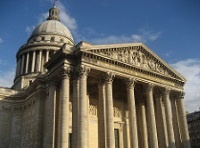
The stately Pantheon is one of the world's most inspiring architectural designs; almost two thousand years after it was built, the Pantheon's dome is still the world's largest unreinforced concrete dome. Built as a temple to the Roman gods by Hadrian in 120 AD, its perfectly proportioned floating dome rests seductively on sturdy marble columns. The only light source is the central oculus, which was used by the Romans to measure time (with the aid of a sundial) and the dates of equinoxes and solstices. The sunlight pouring through the oculus and illuminating the floor in the otherwise dark church is quite a sight. The south transept houses the Carafa Chapel and the tomb of Fra Angelico rests under the left side of the altar. The Pantheon is still an active place of worship and Christian services are conducted regularly. Visitors should show respect and keep their voices down; this is not difficult as the interior inspires awe and humility which is perhaps why the atmosphere is almost always peaceful and quiet despite the crowds of people that visit. Photography is allowed and there are audio guides available for hire. One of the most iconic buildings in the world and certainly among Rome's most famous attractions, the Pantheon is a must-see which seldom leaves visitors unaffected.
Address : Piazza della Rotonda
Website : www.pantheon-rome.com/opening-hours/
Telephone : +39 06 6830 0230
Opening times : Open Monday to Saturday, from 8:30am to 7:30pm; on Sundays from about 9am to 6pm. Closed New Year's Day, 1 May and Christmas Day.
Admission : Free
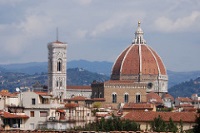
Santa Maria del Fiore, the Duomo or Cathedral of Florence, is set in the heart of the city and perches above the metropolis like an emperor before his subjects. Its most distinctive feature is the enormous dome, designed by Filippo Brunelleschi and built between 1420 and 1436. Visitors can climb between the two shells of the cupola for an unrivalled panorama of the city.The original Gothic exterior was destroyed in 1587 so that it could be replaced by the styling of the High Renaissance. However, this vision died prematurely with its patron, the Grand Duke Francesco de Medici, and the funding to build the neo-Gothic façade that we see today was not found until the 19th Century. The Campanile (bell tower) was built according to Giotto's designs in 1334, and is an elegant prop to Brunelleschi's stout Cathedral. The tower is decorated with two garlands of bas-reliefs, strung around its pink, white and green marble façade. Above, sculptures of the Prophets and Sybils, carved by Donatello, look down upon the city below.The Campanile can also be climbed for the magnificent views over the square and the adjacent cathedral. The neighbouring Baptistry, with its famous doors designed by Lorenzo Ghiberti, is one of Florence's oldest buildings and was originally a pagan temple. The gilded brass doors, dubbed the 'Gates of Paradise', were commissioned in 1401 to mark Florence's deliverance from the plague. The original panels are in the Museo dell'Opera del Duomo (the Duomo Works Museum), which exists largely to safeguard the sculptures removed from the doors and niches around the Piazza del Duomo. The museum also contains the machines used in the construction of the cathedral's dome, and has displays devoted to the problematic construction of the cathedral's façade. A room containing Ghiberti's baptistry doors provides an opportunity to closely examine the stiacciato relief technique used.Other noteworthy artefacts found in the museum include Michelangelo's Pieta, the carved figures of Donatello's Prophets as well as his Magdalene sculpture. In the anteroom are Andrea Pisano's panels from the first few levels of the bell tower.
Address : Piazza Duomo
Website : www.duomofirenze.it/index-eng.htm
Telephone : +39 0173 366167
Opening times : Cathedral open Monday to Saturday, from 10am to 5pm (Thursdays until 3:30pm; Saturdays until 4.45pm); and on Sundays from 1.30pm to 4.45pm. Museum open Monday to Saturday from 9am to 7.30pm, and on Sundays from 9am to 1.40pm
Admission : Cathedral entry is free, but there are admission fees for the baptistry, the dome, the cupola and museum.
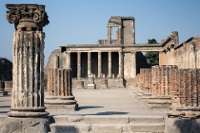
In the year 79 AD Mount Vesuvius erupted, burying the Roman city of Pompeii in volcanic lava and ash. The most evocative testimony to its victims is the 'frozen people', plaster casts of the victims whose anguished contortions and facial expressions reveal the horror of their untimely deaths. The excavation of Pompeii, which started after its accidental rediscovery in 1749, is an ongoing process and every decade has brought to light new finds that provide insight into daily Roman life. A comprehensive tour of Pompeii's attractions will take approximately five hours. Guided tours are available but are pricier alternatives to doing it alone. There is an informative 'How to Visit Pompeii' guidebook for sale outside all the site entrances.Pompeii is one of Italy's most popular tourist attractions, seeing nearly 2.5 million visitors every year. It is one of the most intriguing ancient sites in the world and a full day of walking barely covers the many sights of interest. The Pompeii site has been plagued by mismanagement but has recently been granted a huge injection of funds which should improve maintenance; however, the place is so captivating that no amount of mismanagement can deter visitors from travelling to Pompeii, and the four associated sites of Herculaneum, Oplontis, Stabia and Boscoreale.
Website : www.pompeiisites.org
Transport : SITA bus to Piazza Esedra in Pompeii; or Circumvesuviana train line from Central Station to Pompeii Scavi station
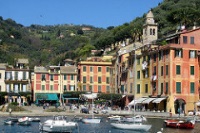
Nestled in a sheltered inlet within the stretch of the Italian Mediterranean is the coastal fishing village of Portofino which is famous for its picturesque harbour and has become an upmarket resort. It has long been the playground for the rich and famous, attracting the likes of Humphrey Bogart, Sophia Loren, Richard Burton, Elizabeth Taylor and Princess Grace. It is not surprising, therefore, that its prices rose to match the exclusivity demanded by its holidaymakers. The scenic surrounds can be explored from the outlying nature reserve, graced with cypress and olive slopes. Set off from here on a 90-minute trek to San Fruttuoso, or a two-and-a-half hour hike to Santa Margherita. Other sights around Portofino include its castle and the lighthouse (faro), with its breathtaking view of the coastline. The most famous beach in the area is the beautiful Paraggi Beach, which is a few minutes up the coast. Other popular beaches nearby include Camogli, Chiavari, Lavagna, and Sestri Levante. Portofino is sometimes a victim of its own popularity and can get uncomfortably crowded in the summer months, but it is well worth the effort to spend a few hours exploring this famously scenic and famously celebrity-packed village.
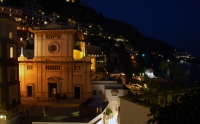
Despite the invasion of tourists over the summer months, Positano retains the authentic character that enamoured artists and writers, including Picasso, Escher, and Steinbeck. Pastel-coloured houses and bougainvillea-draped hotels are connected by steep roads and steps to a boat-filled harbour below. In the town centre is the cobbled Flavio Gioia square, which is surrounded by boutiques, bars, and restaurants. Rising above is the 11th-century Basilica di Santa Maria Assunta, with its beautiful golden dome.There are two main beachs in Positano. Just below the town centre, Spiaggia Grande is the most popular. Its expanse of dark sand is packed with deckchairs and sunbathers. Boat trips and watersports can be arranged at the harbour. Spiaggia del Fornillo is Positano's second beach, and is worth the easy ten-minute stroll from the centre. The pebbly shore slopes gently into the beautiful warm, azure waters of the Mediterranean.Those looking for more than a beach holiday can explore some of the lovely hiking trails found in the surrounding Monti Lattari mountain range. Sorrento and Amalfi are a short drive away, and there is a daily ferry to Capri from the harbour.
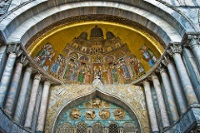
St Mark's Square (Piazza San Marco) has always been the nucleus of Venice. The city's first citadel and church were erected on its stony foundations: the Palazzo Ducale and the Basilica di San Marco, respectively. The Basilica di San Marco is a unique juxtaposition of Byzantine, western European and Islamic architectural styles. The Basilica's most precious relic is the Pala d'Or, a Venetian-Byzantine gold relief adorned with precious gems. Travellers and pigeons flock to the Piazza with equal zeal. It is the tourists, however, who pay dearly to eat or drink at the elegant cafes that spill onto the pavements. The pigeons are an attraction in themselves for children, and if you are travelling to Venice with kids they will relish the chance to feed the birds in this romantic place. Designer shops line the streets that radiate from the square. There are worthwhile places of interest to explore beyond the square that include the Museo Correr, the Archaeological Museum and the Museo del Risorgimento, which are housed within the Procuratie Nuova. Attached to the Procuratie Vecchie is the triumphal Torre dell'Orologio. The adjoining archway guides one through to the Mercerie, Venice's main commercial street, that stretches to the famous Rialto Bridge.
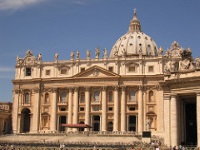
The Basilica lies above the reputed site of St. Peter's tomb. It has an overwhelming interior, containing notable sculptures including Michelangelo's Pieta, which is protected by bullet-proof glass since the damaging attack on it in 1972. In the central aisle stands Arnolfo da Cambio's bronze statue of St Peter, its foot worn down by the constant flow of pilgrims' kisses. Proudly resting above the papal altar is Bernini's Throne of St Peter. The Vatican Grottoes, containing papal tombs, can be reached by steps from the statue of St Longinus. The Necropolis is located one level below the grottoes. This is the legendary site of St Peter's tomb and advance permission has to be obtained to view it. Tours of the Necropolis, called the Scavi Tour, take about 90 minutes and are fascinating but must be booked well in advance. Children under 11 are not permitted on the tour. A strict dress code is in place for St Peter's Basilica and no shorts, bare shoulders or miniskirts are allowed (for men and women). There are frequent religious services at the Basilica which may disrupt visiting times. St Peter's Basilica is one of the most famous religious attractions in the world and even from a secular perspective is breathtakingly impressive, with enough art and history on offer to impress even the most experienced of travellers.
Address : Piazza San Pietro
Website : www.stpetersbasilica.info/contacts.htm
Telephone : +39 06 6988 5435
Opening times : Open daily from 7am to 7pm (April to September), and 7am to 6pm (October to March).
Admission : Entry to the Basilica is Free. Entry to the Dome carries a charge.
Known to be one of the most impressive buildings of the Roman Empire, the Colosseum was the largest structure of its era. Emperor Vespasian, founder of the Flavian Dynasty, started construction of the Colosseum in 72 AD and it was completed in 80 AD. This enduring symbol of ancient Rome, which used to be called the Flavian Amphitheater, tenaciously clings to its foundations as the site of former gladiatorial conquests and brutal public entertainment. Its architecture boasts an impressive array of Doric, Ionic and Corinthian columns and an underground network of cells, corridors, ramps and elevators that were used to transport animals from their cages to the arena. It could once hold a crowd of 55,000 spectators and had 80 entrances. Emperors staged days of free public entertainment in this vast building, and not all the games were brutal and blood-thirsty - they often began with comedic acts and exotic animal displays, but did invariably include gladiatorial fights to the death. The magnificence of the original structure has been eroded through the years by pillaging and earthquakes so that only a skeletal framework remains; however, the sense of history the Colosseum is still able to evoke is truly awe-inspiring and it remains one of Rome's knock-out attractions, featuring on the bucket lists of many a traveller.
Address : Piazza del Colosseo
Website : www.the-colosseum.net/around/visit.htm
Telephone : +39 06 700 4261
Opening times : Open daily from about 9am to 6:15pm in summer, and from 9am to 4:30pm in winter. Times vary depending on sunrise and sunset.
Admission : €12 (adults); €7 (reduced fee)
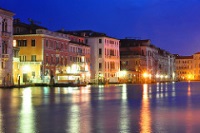
Venice's main waterway splits the city in half, with sestieri in equal parts to the west and east of it. It is the hub around which much activity in Venice is concentrated and is encircled with the elegant facades of the palazzi, which testify to the city's past opulence. Many of the picture-perfect scenes that make Venice famous can be discovered along the Grand Canal.The best way to explore the architectural splendour of these Renaissance buildings is on board a vaporetta. Pedestrian access across the canal is only provided along three bridges situated at the station, Rialto and Academia. Gondolas cross the canal at regular intervals and provide a romantic interlude to the sightseeing itinerary. Although a gondola ride along the Grand Canal is glorious, it is often better to explore the smaller waterways by gondola, as the Grand Canal can become crowded and stressful in peak season.Grand Canal palaces and buildings to look out for include the Ca da Mosto, with its rounded arches in low relief; the 'House of Gold' (Ca d'Ora), a beautiful Gothic building constructed between 1424 and 1430; and Palazzo Corner-Spinelli and Palazzo Vendramin Calergi, which combine classical and Byzantine elements designed by Mauro Codussi. Architect Jacopo Sansovino was inspired by Codussi's style and infused this in his creation of the Palazzo Corner (Ca Granda). Another notable Palazzo is the Grimani di San Luca, designed by Michele Sanmicheli.
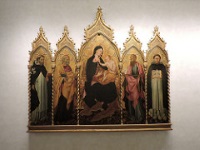
The Uffizi is one of the world's greatest art galleries, with a collection of Renaissance paintings that includes the works of Giotto, Masaccio, Paolo Ucello, Sandro Botticelli, Leonardo da Vinci, Michelangelo, Titian and Caravaggio. The collection is housed on the top floor of a building designed as the offices (uffizi) of the Medici, commissioned by Duke Cosimo I. From 1581, Cosimo's heirs used the upper storey to display the Medici art treasures. Ancient Greek and Roman sculptures line the inner corridors of the gallery and a series of rooms jut off from here, showcasing the chronological development of Florentine art from Gothic to High Renaissance and beyond. The scale and magnitude of the collection may need to be enjoyed over two visits. Rooms 1-15 (Florentine Renaissance) could be explored more thoroughly on the first trip and on the next visit one could concentrate on rooms 16 to 45 (from High Renaissance to later Italian and European paintings). The Uffizi is a must-see attraction in Florence if you have any interest in and appreciation for art, and many would argue that if you only visit one gallery in Italy this should be it. The queues can get frustratingly long so it is best to arrive as early as possible.
Address : Loggiato degli Uffizi 6
Website : www.beniculturali.it/mibac/export/MiBAC/sito-MiBAC/Luogo/MibacUnif/Enti/visualizza_asset.html_126669143.html
Telephone : +39 055 238 8651
Opening times : Open Tuesday to Sunday from 8.15am to 6.50pm. Closed on Mondays, 1 January, 1 May and 25 December.
Admission : Ticket prices vary, concessions are available. Special exhibitions have an excess fee
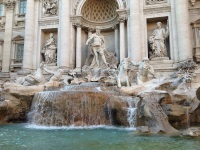
The tiny Piazza di Trevi has been immortalised through this fountain, built for Pope Clement XII. Arguably the most famous and most beautiful fountain in all of Rome, and the largest Baroque fountain in the city, the statues adorning this watery display represent Abundance, Agrippa, Salubrity, the Virgin and Neptune guided by two Tritons. The fountain marks the terminal point of an ancient aqueduct that supplied Rome for more than four hundred years. The story of the discovery of the spring of fresh water channelled into this aqueduct is represented on the fountain's facade. Tossing a coin into the fountain (over your shoulder, with your back turned to the water) is supposed to guarantee a return trip to Rome. This well-known myth has ensured that thousands of euros are thrown into the fountain every day by tourists desperate for a chance to return; the money is used for charitable projects so visitors are at least supporting a good cause, although often unknowingly. There are regular attempts to steal money out of the fountain as well! The Trevi Fountain has been immortalised in many films and has become a top attraction in Rome. The best time to visit is at night when it is stunningly lit up.
Address : Piazza di Trevi
Website : www.trevifountain.net/
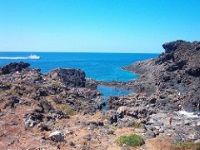
An underwater city and a landscape of petrified black lava are the characteristics of the unusual little island of Ustica in the Tyrrhenian Sea, just a short ferry ride of 36 miles (57km) from Palermo. The ancient volcanic island was once inhabited by the Phoenicians and often fell prey to pirate raids during the Middle Ages; there is evidence of many shipwrecks off the island and the Greeks believed it was inhabited by sirens that lured ships to their doom on the rocks. Ustica has been inhabited since the Paleolithic era and notable archaeological remains have been uncovered. The Phoenicians, Greeks, Carthaginians and Romans all left their mark on the landscape. In the 20th century Ustica became a penal colony but in 1961 tourists officially replaced prisoners. Today, the island is a designated national marine park and its crystal-clear waters and undersea treasures, particularly the submerged ancient city of Osteodes, attract divers from all over the world. The snorkelling is also brilliant, as the waters around the island teem with marine life. Every year in July the island is the venue for an International Underwater Activity Show. Ustica is a delightful excursion which can occupy visitors happily for one to two days, but unless you are an avid diver, you won't need more time than that to explore the island.
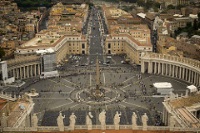
The Vatican City is a remarkable entity in that it is an independent state administered by the Roman Catholic Church, and one of the world's richest countries. The population of this enclave doubles during the working week as residents from Rome cross into the Vatican City to work within its boundaries. Scandal and intrigue has somewhat tarnished the papacy's image over the years, but this does not detract from the magnificence of the art collections housed within its buildings, or the passion the city inspires in the many pilgrims who flock to its holy sites. Pope Francis has brought the Vatican back into the limelight in many positive ways. The must-see attractions when on holiday in the Vatican City include St Peter's Basilica, the Vatican Museums, and the Sistine Chapel.The Sistine Chapel, one of Italy's most popular attractions, is known for the famous ceiling, painted by Michelangelo, which looms above the frescoes on the side walls, painted by an illustrious team of artists that included Botticelli, Ghirlandaio, Roselli, Pinturicchio, Signorelli and della Gatta. The altar wall is covered by Michelangelo's Last Judgement, revealing the figure of Christ hovering above centre and flanked by Mary and other saintly figures. The chapel is justified in its fame and leaves travellers breathless; it is a profoundly special place to visit.The Vatican Museums provide access to one of the world's greatest collections of art. The galleries stretch over four miles (6km), and include the magnificent Raphael Rooms, the Etruscan Museum, and the Pio-Clementino Museum, which boasts the world's largest collection of Classical statues.
Address : Viale Vaticano
Website : www.vatican.va

Travel Guide powered by Word Travels, copyright © 2023 Globe Media Ltd. By its very nature information in this travel guide is subject to change at short notice and travellers are urged to verify information on which they're relying with the relevant authorities. Neither Globe Media Ltd nor Travel Vogue can accept any responsibility for any loss or inconvenience to any person as a result of information contained above.